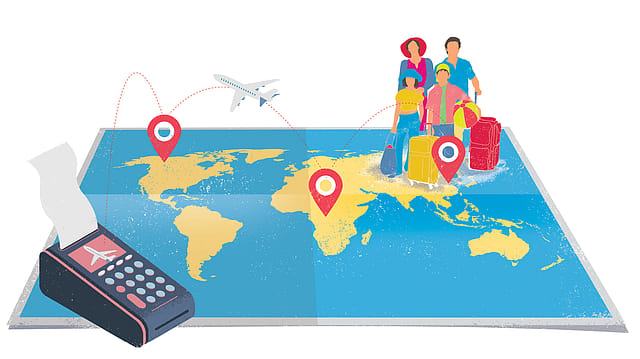India’s travel boom 2025: From digital nomads to spiritual odysseys, a new era takes flight
ADVERTISEMENT

India's appetite for travel is set to soar. From offbeat domestic adventures to bold international expeditions, the industry is evolving to meet the demands of a new era. Stakeholders are preparing for a year brimming with opportunities and formidable challenges.
The domestic travel landscape is undergoing a significant transformation. Religious tourism, a cornerstone of Indian travel culture, which saw a steady 30–40% month-over-month growth in 2024, continues its strong momentum. Bus travel to spiritual hubs such as Tirupati, Shirdi, and Varanasi recorded a staggering 69% year-on-year increase. “Continued government investments in infrastructure and new corridor developments at key religious sites are expected to drive further growth in spiritual tourism in 2025,” says Rajnish Kumar, group co-CEO of Ixigo.
Tier-2 and Tier-3 cities are playing a crucial role in this expansion. Airports in cities like Varanasi and Vijayawada reported over 50% annual growth in passenger traffic. With rising middle-class aspirations, these regions are not only fuelling domestic travel but also contributing significantly to international outbound journeys. “With growing household incomes and increasing aspirations, experiential travel is set to surge. These cities are emerging as key contributors to both domestic and international travel,” adds Kumar.
India’s outbound travel spending reached $17 billion in FY24 and is projected to rise further, supported by simplified visa processes and enhanced flight connectivity. Searches for destinations such as Vietnam, Indonesia, and Mauritius have surged by 50–80% year-on-year. Emerging locales like Uzbekistan and Georgia are also gaining popularity, driven by visa-on-arrival policies and affordability. “In 2025, India’s travel sector is set for substantial growth, propelled by a surge in domestic exploration of offbeat destinations and an increase in international tourism, aided by improved connectivity and easier visa access,” says a Paytm spokesperson, adding that enhanced digital tools are making the transition seamless for Indian travellers.
January 2026
Netflix, which has been in India for a decade, has successfully struck a balance between high-class premium content and pricing that attracts a range of customers. Find out how the U.S. streaming giant evolved in India, plus an exclusive interview with CEO Ted Sarandos. Also read about the Best Investments for 2026, and how rising growth and easing inflation will come in handy for finance minister Nirmala Sitharaman as she prepares Budget 2026.
Tech-Powered Travel
Technology is redefining the travel experience. AI-driven solutions, from personalised recommendations to real-time itinerary planning, are transforming consumer behaviour. In 2024, over 1.3 million users engaged with AI trip planners, generating nearly 300,000 custom itineraries. Meanwhile, India’s UPI system continues to expand, surpassing 15 billion transactions worth over ₹20 lakh crore each month. “This seamlessly extends into the tourism sector, which contributes 6.5% to GDP, by simplifying payments across the travel ecosystem,” says Mrigank Gutgutia, partner at Redseer.
India’s rapidly expanding digital infrastructure is also elevating traveller expectations. “Customised itineraries and smooth, hassle-free online booking experiences are becoming the norm, further driving domestic tourism growth,” notes Zubin Saxena, senior vice president at Hilton.
The hospitality sector is embracing innovation, with IoT-enabled solutions and biometric systems enhancing guest experiences. Hilton’s Digital Key initiative, for instance, allows guests to unlock doors and select rooms via their smartphones. “With mobile check-ins and keyless entries, the hospitality industry is reducing friction and enhancing convenience,” adds Saxena.
New-Age Travellers
Younger travellers, particularly Gen Z and Gen Alpha, are emerging as influential decision-makers. According to Hilton’s 2025 Trends Report, 93% of these cohorts actively participate in family travel planning, signalling a shift toward more inclusive decision-making. “This generation values cultural exploration and meaningful interactions,” says Saxena. With 88% eager to reconnect with their roots, destinations showcasing India’s heritage are witnessing increased interest. “We are seeing a sharp rise in spontaneous travel, short-duration trips, and experiential tourism focused on local and immersive experiences,” notes Gutgutia.
Solo female travel is another growing trend. Ixigo data reveals a 51% increase in solo female bus travellers in 2024. Empowered by improved safety measures and evolving societal norms, women are increasingly embracing independent journeys. Sneha Singh, a PhD candidate in plant biotechnology, has made solo birthday trips an annual tradition. Her latest adventure took her trekking through Sikkim’s serene landscapes. “These trips give me the best of both worlds—connecting with new people while also enjoying moments of solitude,” she shares. With each journey, she adds, her confidence as a solo traveller grows.
Challenges on the Horizon
Despite the optimism, the travel sector faces several hurdles. A shortage of skilled manpower, inflationary pressures, and geopolitical uncertainties could temper growth. Rising crude oil prices, for instance, could push up airfares, dampening travel demand, notes Gutgutia.
“Popular destinations, including hill stations, beach towns, and heritage cities, risk infrastructure bottlenecks. Hospitality businesses still grapple with complex state-level regulations, despite localised simplifications,” warns Arnav Arya, senior consultant at Redseer. Moreover, climate extremes—such as erratic monsoons and heatwaves—pose additional threats to peak travel seasons, necessitating adaptive strategies from both policymakers and businesses.
India’s tourism story remains one of resilience and reinvention. The sector is expected to play a significant role in the economy, with India projected to become the world’s fourth-largest travel spender by 2030. Outbound tourism is set to triple over the next decade. As domestic air travel surges—making India the third-largest domestic airline market—the industry’s ability to innovate and adapt will be critical.
The emphasis on personalisation, immersive experiences, and digital integration will define 2025. Whether through AI-powered tools or sustainable travel practices, the sector is aligning itself with the aspirations of a new generation of travellers. “India’s travel and tourism sector will be shaped by a blend of relaxation and immersive experiences, with slow, meaningful travel taking centre stage,” concludes Saxena.
